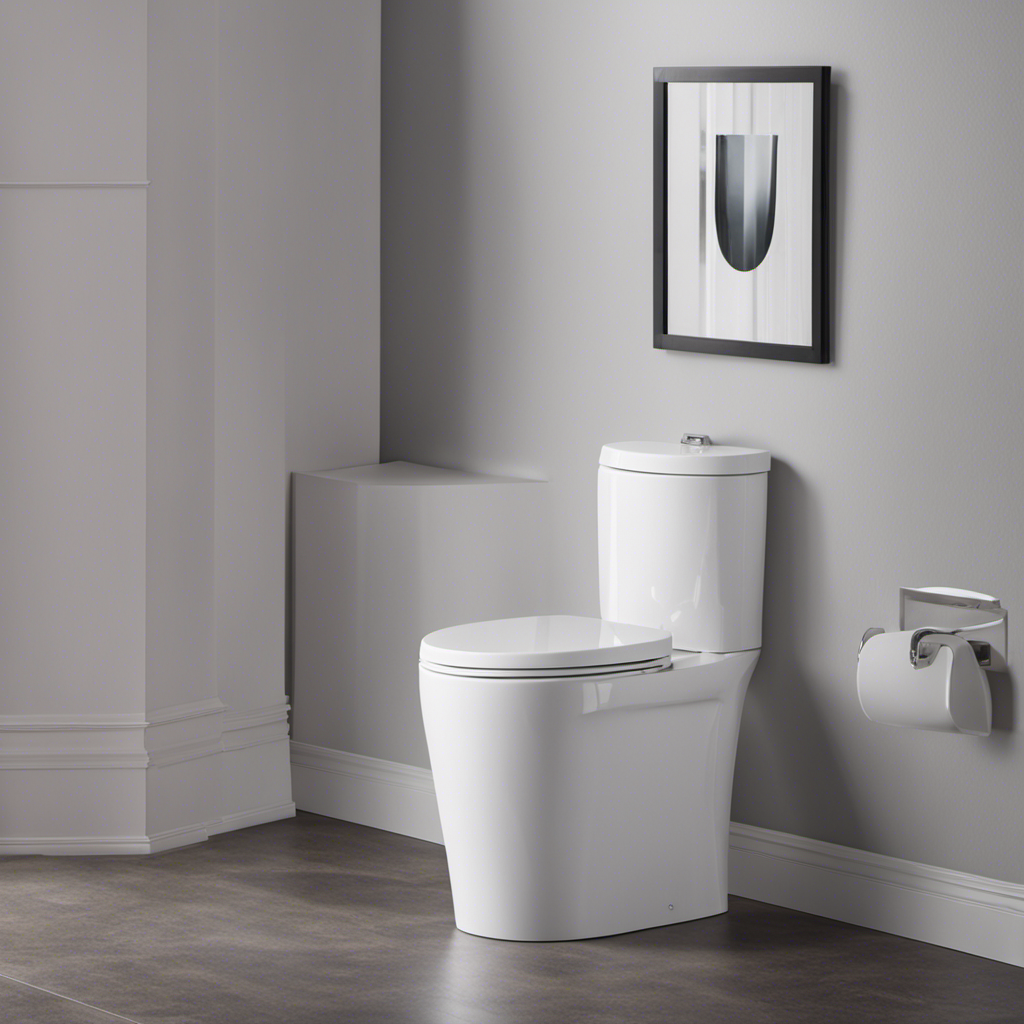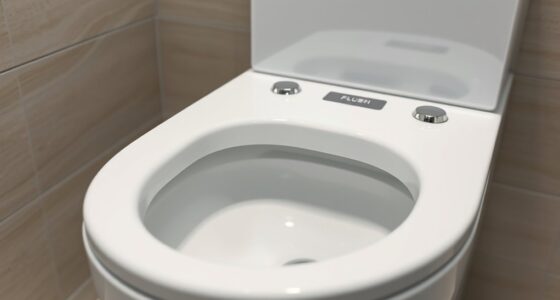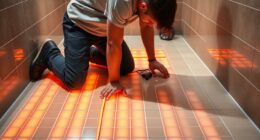Have you ever wondered why your legs fall asleep on the toilet? It’s a strange sensation, isn’t it? Well, let me enlighten you with some scientific knowledge.
The Science Behind It involves blood flow and nerve compression, as well as the positioning and pressure points of your body.
In this article, I’ll explain the reasons behind this phenomenon and provide some tips to prevent and alleviate the discomfort.
So, let’s dive in and uncover the mysteries of toilet-induced leg numbness.
Key Takeaways
- Legs falling asleep on the toilet is caused by factors such as nerve conduction and muscle fatigue.
- Sitting in one position for a long time can compress nerves, disrupting nerve signals and causing numbness.
- Decreased circulation from prolonged sitting can result in compressed and irritated nerves, leading to tingling and numbness.
- Proper positioning, avoiding excessive pressure, and using ergonomic seating options can help prevent leg numbness on the toilet.
The Science Behind It
The science behind why your legs fall asleep on the toilet is still not completely understood. However, researchers have identified two key factors that contribute to this phenomenon: nerve conduction and muscle fatigue.
When you sit on the toilet for a prolonged period, the nerves in your legs can become compressed or pinched, disrupting the normal flow of nerve signals. This can lead to a tingling or numb sensation.
Additionally, sitting in one position for an extended period can cause muscle fatigue. The muscles in your legs may not receive enough blood flow, resulting in a lack of oxygen and nutrients. As a result, the muscles may feel weak and numb.
While these explanations provide some insight, further research is needed to fully understand why this occurs.
Blood Flow and Nerve Compression
When you sit on the toilet for a while, it’s normal for your legs to start feeling tingly because of decreased blood flow and compressed nerves. Circulation problems and numbness are common causes of this sensation. Let’s take a closer look at how blood flow and nerve compression contribute to your legs falling asleep on the toilet.
When you sit for an extended period, the pressure on your legs can inhibit proper blood circulation. This can lead to a decrease in oxygen and nutrient delivery to the nerves, causing them to become compressed and irritated. The table below provides a visual representation of the relationship between circulation problems, nerve compression, and leg numbness:
| Circulation Problems | Nerve Compression | Leg Numbness |
|---|---|---|
| Reduced blood flow | Compressed nerves | Tingling |
| Poor oxygen supply | Irritated nerves | |
| Nutrient deficiency | ||
Understanding the role of blood flow and nerve compression in leg numbness helps us recognize the importance of proper positioning and avoiding excessive pressure on specific points. Let’s delve into these factors in the next section.
Positioning and Pressure Points
To prevent discomfort, make sure you adjust your position and avoid putting excessive pressure on certain points on your body. When it comes to sitting for extended periods of time, ergonomic solutions and alternative seating options can help alleviate the risk of your legs falling asleep.
Ergonomic chairs with adjustable features, such as height, armrests, and lumbar support, can promote proper posture and reduce the likelihood of nerve compression. Additionally, using cushions or seat wedges can help distribute your weight evenly and reduce pressure on specific points. Some alternative seating options, like exercise balls or kneeling chairs, can also promote better blood flow and prevent numbness.
By incorporating these ergonomic solutions and alternative seating options, you can minimize the chances of experiencing discomfort and tingling sensations in your legs while sitting.
Transitioning into the next section about ‘duration and frequency,’ it’s important to consider how long and how often you sit in order to further prevent leg numbness.
Duration and Frequency
Make sure you’re aware of how long and how often you’re sitting in order to prevent leg numbness. It’s easy to get lost in your thoughts or phone while sitting on the toilet, but prolonged sitting can lead to discomfort and even numbness in your legs. Here are three reasons why you should pay attention to your toilet habits and sitting posture:
-
Blood circulation: Sitting for too long can restrict blood flow to your legs, leading to numbness and tingling sensations.
-
Nerve compression: Poor sitting posture can compress nerves in your legs, causing temporary loss of sensation.
-
Muscle fatigue: Sitting in one position for an extended period can strain your muscles and contribute to leg numbness.
To prevent leg numbness, try to limit your time on the toilet, maintain proper sitting posture, and take breaks to stretch and move around.
Tips for Preventing and Alleviating Discomfort
It’s important to be mindful of your sitting posture and take breaks to stretch and move around in order to prevent leg numbness. One way to alleviate discomfort is by staying hydrated. Hydration plays a crucial role in maintaining proper blood circulation and preventing muscle cramps. Make sure to drink enough water throughout the day to keep your body hydrated. Additionally, incorporating stretching exercises into your daily routine can help relieve leg numbness. Some effective stretching exercises include calf stretches, hamstring stretches, and ankle rotations. These exercises help increase blood flow to the legs and reduce the chances of experiencing numbness. By staying hydrated and incorporating stretching exercises, you can prevent and alleviate leg numbness while sitting for extended periods.
| Hydration and its impact | Stretching exercises for relief |
|---|---|
| Maintains blood circulation | Calf stretches |
| Prevents muscle cramps | Hamstring stretches |
| Reduces leg numbness | Ankle rotations |
Frequently Asked Questions
Is It Normal for My Legs to Fall Asleep on the Toilet?
Yes, it is normal for my legs to fall asleep on the toilet. It could be due to the design of the toilet seat, which puts pressure on certain nerves and restricts blood circulation.
Can Sitting on the Toilet for Too Long Lead to Long-Term Health Problems?
Sitting on the toilet for too long can potentially lead to long-term health problems. Prolonged sitting, especially in a squatting position, can restrict blood circulation and cause issues like hemorrhoids and constipation. It’s important to take breaks and maintain proper posture.
Why Do Only Some People Experience Leg Numbness While Using the Toilet?
When using the toilet, some people may experience leg numbness. Explanations for this include prolonged pressure on the nerves and reduced blood flow. Remedies such as changing positions or taking breaks can alleviate the discomfort.
Are There Any Exercises I Can Do to Prevent Leg Numbness on the Toilet?
To prevent leg numbness on the toilet, try incorporating toilet exercises that improve blood flow. Simple movements like ankle circles or leg lifts can help increase circulation and reduce the likelihood of your legs falling asleep.
Can Certain Medical Conditions Make Me More Prone to Experiencing Leg Numbness on the Toilet?
Certain medical conditions, such as peripheral neuropathy, diabetes, and vitamin deficiencies, can increase the risk of experiencing leg numbness on the toilet. It is important to consult with a healthcare professional for proper diagnosis and management.
Conclusion
After delving into the science behind why our legs fall asleep on the toilet, it’s clear that blood flow and nerve compression play a significant role in this phenomenon.
By understanding the positioning and pressure points involved, we can take steps to prevent and alleviate discomfort.
Remember, the duration and frequency of these episodes can also impact their severity. So next time you find yourself in this awkward predicament, try adjusting your posture and taking breaks to improve circulation.
Your legs will thank you!










